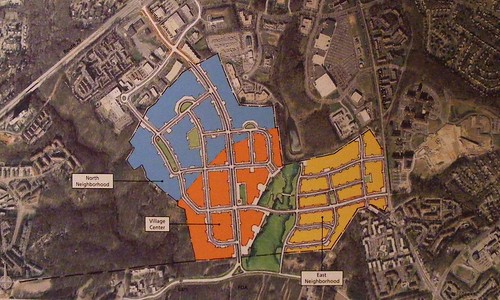
Last week, Montgomery County selected local developer Percontee to turn Site 2, a former sludge treatment plant in White Oak, into LifeSci Village, a $3 billion mini-city designed to compliment the Food and Drug Administration's new campus and a new Washington Adventist Hospital. Despite a series of sexy new project renderings released by Percontee, East County's answer to Cambridge isn't a guarantee yet.
LifeSci Village, which we first wrote about in 2009, would occupy 290 acres on Cherry Hill Road east of Route 29. In addition to the sludge plant, which closed in 1999, the site would include a concrete recycling plant owned by Percontee. Genn has previously said that the project would include roughly two million square feet of offices and research labs, two million additional square feet of shops, hotels and possibly a conference center, and between three and four thousand apartments and townhomes.

Genn has been talking to the county about LifeSci Village and Site 2 since 2004, so it's not surprising that they picked Percontee over two out-of-area developers less familiar with the project. But in 2009, he told me that a groundbreaking was "not anytime soon." The Post, meanwhile, says that construction could start within the next two years.
What's changed? Last year, the MoCo Planning Department started work on the White Oak Science Gateway Master Plan, which will reinforce LifeSci Village's goal of creating a research hub around the FDA. In addition, the county is studying a Bus Rapid Transit network which could have several lines serving the development.

Though LifeSci Village has the blessing of both the county and local residents, the White Oak Science Gateway concept has its critics. A study from economic consultants hired by the MoCo Planning Department says that it won't work unless it can get a major research institution, though Genn says he's talked to "very prominent" D.C.-area universities about locating there. Even then, the consultants say, biotech companies might just continue going to the county's other research and development district, the Great Seneca Science Corridor in Gaithersburg, which Percontee helped develop in the 1980's and where Johns Hopkins University plans their own, similarly-minded "Science City" project.
As exciting as the LifeSci Village proposal is, there remain a lot of questions. Who will provide $3 billion in financing for a research campus without a research institution? Is it practical to build 4 million square feet of commercial space and 4,000 homes in an area with no fixed-rail transit? And will Montgomery County be able to lure biotech companies away from the vaunted "Technology Corridor" along I-270?
East County needs a project like this. But it's not yet clear if LifeSci Village will ever go from being a pretty picture to a reality.

1 comment:
Dan Reed wrote:
As exciting as the LifeSci Village proposal is, there remain a lot of questions. Who will provide $3 billion in financing for a research campus without a research institution? Is it practical to build 4 million square feet of commercial space and 4,000 homes in an area with no fixed-rail transit? And will Montgomery County be able to lure biotech companies away from the vaunted "Technology Corridor" along I-270?
Dan, I question the need for rail transit anywhere in Eastern Montgomery County. Rail along U.S. 29 has been studied more than once since the 1970's and invariably rejected.
Where would it run? How would a rail line connect to the Metrorail system?
Would a rail transit line lead to more pressure to build even more "affordable" housing in the Fairland and White Oak Master Plan Areas?
East County needs a project like this. But it's not yet clear if LifeSci Village will ever go from being a pretty picture to a reality.
I agree that the East Count needs such a project. Especially the employment part of the project - but in the past 20 years, Montgomery County has a dismal record regarding private-sector employment.
Post a Comment